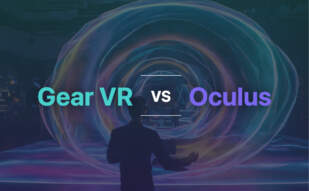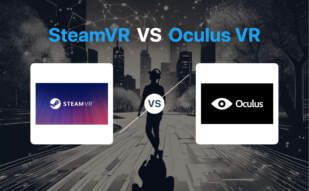For mobile VR-based gaming and simulations, Gear VR’s compatibility with specific Samsung Galaxy devices and use of Three.js deliver a robust experience. If seeking standalone affordability, comfort, and user-friendliness, choose Oculus Go, enhanced with Android 7.0, Oculus Store, and a 3DOF tracking feature.

Key Differences Between Gear VR and Oculus Go
- Platform: Gear VR relies on a compatible Samsung Galaxy device to act as its processor and display. Oculus Go is a standalone VR headset running on Android 7.0.
- Development: Gear VR uses the Three.js library for GPU-accelerated 3D animations. Oculus Go, on the other hand, utilizes Android mobile operating system and has access to the Oculus Store for additional software.
- Hardware: Gear VR connects to a smartphone via USB-C or micro-USB and includes a touchpad, while Oculus Go comes with its own controller featuring a 3DOF tracking feature.
- Support: As of September 30, 2020, Gear VR is no longer supported by Samsung, yet Oculus continues to provide support. Oculus Go, on the other hand, was discontinued on June 23, 2020.
| Comparison | Samsung Gear VR | Oculus Go |
|---|---|---|
| Initial Announcement | September 3, 2014 | October 2017 |
| Initial Release | November 27, 2015 | May 1, 2018 |
| Discontinued | September 30, 2020 | June 23, 2020 |
| Units Sold | 5 million | 2 million (by July 2019) |
| Primary Use | Mobile VR, Gaming, Education | Media Viewing, Gaming |
| Field of View | 96-101 degrees | 101 degrees |
| Main Hardware Goal | MTP latency less than 20ms | User-friendly Standalone VR |
| Support Status | Samsung: Discontinued, Oculus: Continued Support | Discontinued |
| Developer Tools | Three.js | Oculus Store |
| Tracking Type | Rotational (IMU) | 3DOF |
| Operating System | Depends on Galaxy Device | Android 7.0 |
What Is Samsung Gear VR and Who’s It For?
Samsung Gear VR, a virtual reality headset, was a technologically advanced creation by Samsung Electronics and Oculus VR, available between Nov 27, 2015 and Sep 30, 2020, selling 5 million units. The product was predominantly intended for mobile VR-based gaming enthusiasts and also garnered interest from individuals in science and medical education.
The headset required compatible Samsung Galaxy devices to act as a display and processor, while the Gear VR served as a controller with an impressive field of view. Unfortunately, after Sep 30, 2020, Samsung Gear VR was no longer supported by Samsung, but Oculus continues to provide support.

Pros of Samsung Gear VR
- Ease of usage with compatible Samsung Galaxy devices
- Immersive VR experience with a broad field of view through lenses
- Versatility in applications, from gaming to simulations and education
Cons of Samsung Gear VR
- Discontinued by Samsung in 2020
- Limited to specific Samsung Galaxy devices
- No support on Galaxy Note10 and later devices
What Is Oculus Go and Who’s It For?
Oculus Go, a standalone virtual reality headset powered by Meta Reality Labs, Qualcomm, and Xiaomi, offered a portable VR experience between May 1, 2018 and June 23, 2020. It was particularly suitable for users who were seeking comfortable, user-friendly, and affordable VR solutions.
Enhanced with a 5.5-inch fast-switching LCD and an improved Fresnel lenses for an immersive experience, Oculus Go had its operating system based on Android and software available on the Oculus Store. It was discontinued in June 2020.

Pros of Oculus Go
- Standalone, portable VR headset
- Comfortable, user-friendly design
- Variety of apps available for content consumption
Cons of Oculus Go
- Discontinued in June 2020
- Non-positional 3DOF tracking limited to static-standing activities
- Average battery life of only 2.5 hours
Gear VR vs Oculus Go: Pricing
While Samsung Gear VR works with compatible Galaxy devices, Oculus Go hits an affordable price point with its self-contained VR package.
Samsung Gear VR
This technology assumes compatibility with a range of Samsung Galaxy smartphones. The clear cost implication here is the requirement of owning or purchasing a compatible Galaxy device to use Gear VR, as no standalone prices were listed. As of September 30, 2020, Samsung has ceased support for Gear VR, with Oculus still providing support.
Oculus Go
Positioning itself as an affordable, user-friendly option in VR, Oculus Go offered standalone VR with integrated gear, reflected in its pricing. As of January 2020, the prices had been reduced to $149 for the 32GB model and $199 for the 64GB model. This comprehensive packaging attracted an estimated 2 million sales by July 2019 before the product got discontinued in June 2020.
Which Technology Triumphs? Gear VR or Oculus Go?
As we delve into the core of this high-tech duel between Samsung Gear VR and Oculus Go, the decisive winner isn’t universal. It greatly depends on varied user profiles and application needs. Read on to find your perfect match.
Pro-Gamers and Simulator Adventurers
If you are a gaming enthusiast, Samsung Gear VR may satiate your thirst for immersive, mobile VR-based gaming experiences. Given its low MTP latency (below 20ms) and high-res rendering capability allowed by Galaxy Note 4 QHD display, the Gear VR can effectively support fast-paced, graphically intensive games. However, the Oculus Go does serve as a decent alternative when viewing media is a significant part of your VR preferences.

Web-based 3D Graphics Enthusiasts
Leaning towards web-based 3D creations using WebGL? The Gear VR brings the power of Three.js JavaScript library to you. With GPU-accelerated 3D animations compatibility and a vibrant GitHub community, it is a compelling choice for developing and hosting animations within the browser environment. Oculus Go, however, does not quite hit the mark in this segment.

Comfort Conscious VR Users
Oculus Go is your sure-shot winner. Advantaged by its lightweight design, comfortable faceplate material, and adjustable head straps, it promises a snug and cozy VR experience that is user-friendly and comfortable even for extended usage. Gear VR, although poised as a decent competitor, doesn’t quite match up to Oculus Go’s comfort quotient.

Budget-Concerned Consumers
If cost plays a substantial role in your gadget selection, Oculus Go steals the show. With prices reduced to just US$149 for 32GB and $199 for 64GB, it presents a highly affordable and capable VR option. Whereas the Gear VR, despite its robust functionalities, requires a compatible Samsung Galaxy device, which could potentially inflate the overall expenditure.

For simulator adventurers plunging into rapidly evolving realms, Gear VR offers a performance-driven choice. For those seeking comfort and budget-convenience, Oculus Go is the way to go. Remember, the best VR headset is tailored to fit your unique user profile and application requirements.
Hannah Stewart
Content writer @ Aircada, tech enthusiast, metaverse explorer, and coffee addict. Weaving stories in digital realms.





